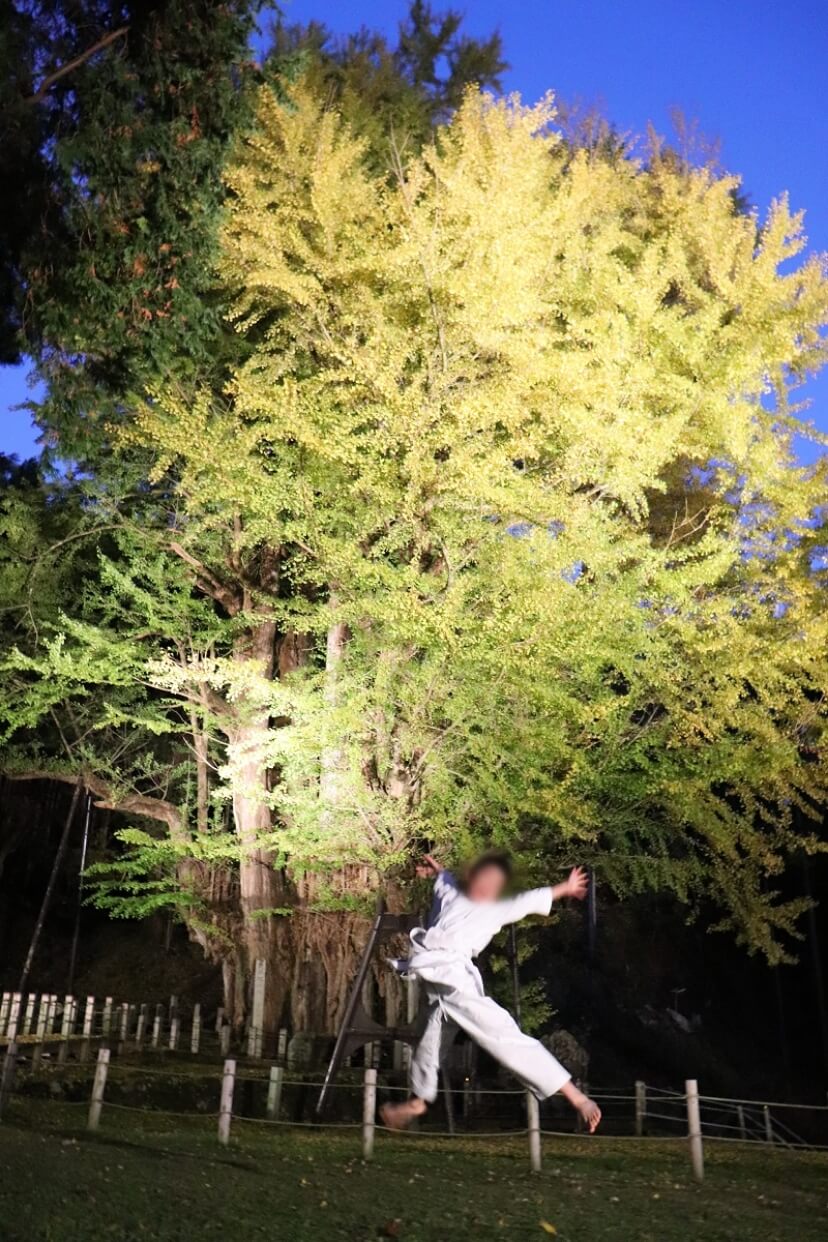
I went to “the big ginkgo tree of Bodai-ji” in Nagi-town.
ボクは、奈義町にある「菩提寺(ぼだいじ)の大イチョウ」に行った。
It’s a verrry big, old and beautiful tree.
とても大きくて古い、キレイな木だ。
What is “Bodai-ji”?(菩提寺とは)

Bodai-ji is a kind of “family temple”.
菩提寺とは、先祖代々のお墓を持つお寺のことです。
So Bodai-ji isn’t a name of the specific temple.
つまり、特定のお寺の名前ではありません。

Japanese Buddhism includes many sects.
日本の仏教には、たくさんの宗派があります。
Therefore many kinds of temples are in Japan, and the reasons built each are different.
そのため、日本にはたくさんの種類のお寺があり、それぞれ建てられた理由も異なります。
The most common temples are Bodai-ji.
その中でも最も一般的なお寺が菩提寺です。
You can pray at the Bodai-ji, even if you aren’t a Buddhist.
菩提寺は、仏教徒でなくてもお参りすることができます。
How to pray(参拝の仕方)

At first you bow in front of the gate.
まず、入口の門に一礼します。
You must not step on the threshold when you pass through the gate.
門をくぐる時に、敷居を踏んではいけません。
When you put on a hat, you take it off.
帽子をかぶっている場合は脱ぎましょう。
You walk the corner of the approach to a temple.
参道は端っこを歩きます。
Because the center of the approach to a temple is the way which God goes along.
なぜなら、真ん中は神様が通る道だからです。
※You don’t need to take off your shoes.
靴は脱がなくてもいいです
Chozuya(手水舎)

If there are a chozusha, you wash your hands and rinse your mouth.
もし、手水舎(ちょうずや・ちょうずしゃ・てみずや・てみずしゃ)があれば、そこで手と口を清めます。
How to use a chozusha(手水舎の使い方)
1.You take one of the ladles by your right hand, fill it with water, and rinse the left hand by pouring some of the water over the hand.
右手で柄杓に水をくみ、左手を洗います。
2.You grasp the ladle with your left hand, fill it with water, and rinse the right hand by pouring some of the water over the hand.
柄杓を左手に持ちかえ、右手を洗います。
3. You grasp the ladle with your right hand again, fill some of the remaining water in the cupped left hand, and rinse the mouth
柄杓を右手に持ちかえ、左手に水を注ぎその水で静かに口をすすぎます。
4.You grasp the ladle with your right hand again, fill it with water, and rinse the left hand by pouring some of the water over the hand.
また柄杓を右手に持ち、左手を洗います。
5.You hold the ladle vertically and rinse it by pouring some water over its shaft.
残りの水で柄杓の柄の部分を流して元に戻します。
※Don’t transfer the water directly to your mouth.
柄杓に直接口をつけてはいけません
a temple bell(お寺の鐘)

You can strike a temple bell before worship.
参拝前に鐘をつくこともできます。
That means greeting for God.
これは、神様にあいさつする意味があります。
※It is said to be “Modori-gane” and is unlucky that you strike a temple bell after worship.
参拝後に鐘をつくのは「戻り鐘」といわれ、縁起が悪いです
※Some of temples are prohibition to strike a temple bell.
お寺によっては、鐘をつくのを禁止している場合もあります
Bodai-ji in Nagi-town(奈義の菩提寺)

A famous Bodai-ji is in Nagi-town, Okayama.
岡山県奈義町には有名な菩提寺があります。
Why it is famous there…
どうして有名かというと、
- about 900 yaears old(樹齢推定900年)
- about 40M in height(高さ約40m)
- about 13M around the trunk(目通り幹囲約13m)
There is the biggest ginkgo tree in Okayama.
岡山県で一番大きな銀杏(いちょう)の木があるからです。
The biggest ginkgo tree(大イチョウ)

This ginkgo tree is appointed to the natural monument of the country.
この木は、国の天然記念物に指定されています。
And It’s one of Japan’s Top 100 tree.
また、全国名木百選の一つでもあります。
As for this big ginkgo tree, the stick which Honen prays for the study accomplishment and placed is said to have sent out buds.
この大イチョウは、浄土宗開祖の法然上人が学問成就を祈願して挿した杖が芽吹いたといわれています。
※Honen (1133-1212): Founder of Japan’s Jodo (Pure Land) Sect
法然上人(1133年-1212年)日本の浄土宗の開祖
on Instagram(インスタの写真)
You must not play in temple.
お寺でふざけてはいけません。
It’s freezing.
すごく寒いです。
The tree is 900years old and I’m 10years old.
900歳の木と10歳のボク。
Location(場所)
Adress:1532, koen, Nagi-town, Okayama.
住所: 岡山県勝田郡奈義町高円1532
The temple is known for its colored autumn leaves, and the site is illuminated at night.
紅葉シーズンはライトアップされます。
The parking lot and Admission are free of charge.
駐車場・入場料無料です。
Please visit my blog again soon.
また見に来てくださいね。
RYU



